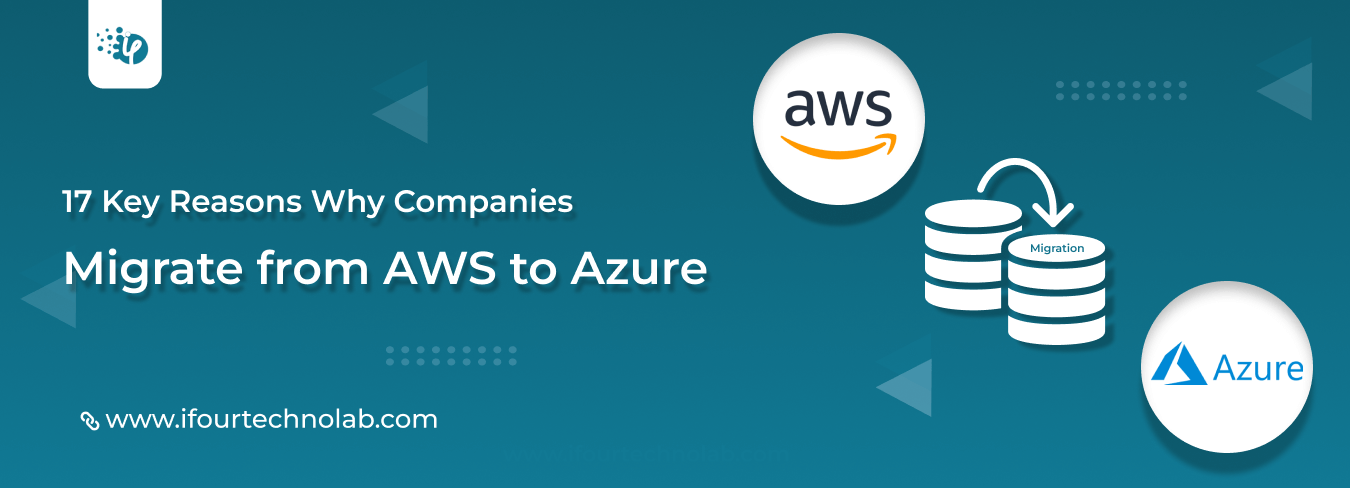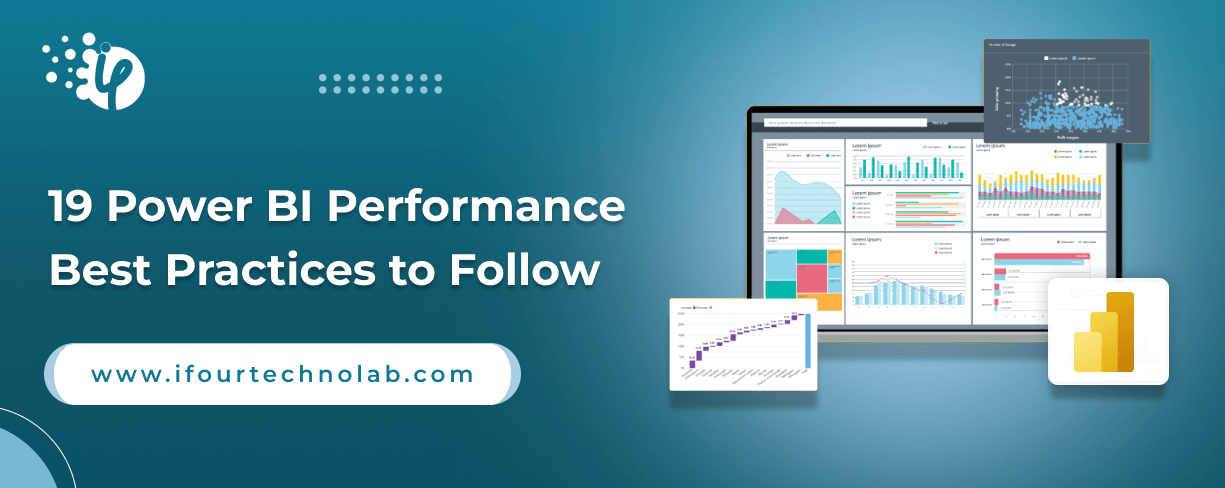Power BI Report Server: Key Features and Elements
Every CTO knows the struggle of managing complex reports. The inefficiency of scattered data, the constant juggling between reporting tools, the challenge of ensuring accurate KPIs...
Vinod Satapara - January 23, 2025
Listening is fun too.
Straighten your back and cherish with coffee - PLAY !

You might ask “why migrate from AWS to Azure when it already offers so many options?” This question is valid, but there's a reason why businesses are moving to Azure.
First, Azure's seamless integration with other Microsoft products, like MS O365 and Dynamics 365, streamlines core operations effectively.
Next, Azure is a PaaS platform, so you are not required to maintain virtual machines (VMs) by yourself, which is not readily available in AWS.
Third, Azure's hybrid cloud capabilities provide greater flexibility and control over your data and applications.
Azure's strong focus on security and compliance can give you peace of mind, knowing your data is well-protected. In this blog, we will walk through 17 major reasons why CTOs migrate from AWS to Azure.
In our experience with industry-specific clients, we've observed some fascinating differences in how large companies and small businesses adopt cloud services, particularly with Amazon Web Services and Azure.
You’d find strong security in both, but with Microsoft Azure, you’d see unique benefits and integration capabilities which is not supported in AWS.
Here are the 17 reasons to migrate from AWS to Azure
One of the major aspects any CTO is concerned about is affordability. Microsoft Azure is a cost-effective cloud service offering key features like Azure Reserved Instances and hybrid functionalities, which help you access resources, anywhere, anytime!
It streamlines your operations and makes everything run smoother. Let’s understand it better with a real-world example.
Get rid of performance concerns with our Azure Cloud Consulting Services
A mid-sized fintech firm faces unpredictable spending on on-premises infrastructure and IT services specifically.
Now, to deal with this, they require a scalable, and cost-efficient cloud solution for their growing business. That’s where Microsoft Azure comes in.
Microsoft Azure services are designed to meet the core needs of any business looking for digitalization. It offers seamless integration with the Microsoft 365 ecosystem embracing Office 365, Power BI, and Dynamic 365. Here’s an example scenario to understand it.
Imagine a Retail business which relies on Microsoft tools, let’s say - MS Dynamics 365 and Office 365 but struggles with inefficiencies (because of fragmented systems and data silos).
Now what they require is a reliable cloud solution which seamlessly integrates with their current ecosystem and makes their collaboration and decision-making process better.
Boost productivity with custom Microsoft 365 solutions
That’s why migrate from AWS to Azure is essential. MS Azure empowers businesses already using Microsoft tools with seamless integration, centralized operations, and enhanced collaboration.
Another reason why companies transit from AWS to Azure is to achieve top-tier security and compliance standards. Let’s understand it with an example.
Let’s say a healthcare setup maintains sensitive patient data and struggles with aligning compliance and regulations (ex: HIPAA and GDPR). This is where Azure cloud services can help.
AWS and Azure both have great security features, but they do things a bit differently. If you really like using Microsoft tools and want a security system that works well with them, then moving to Azure is the best choice.
Learn more about AWS cloud security vs Azure cloud security here here. Now what are the challenges businesses often face with security? Here are they:
Regulatory Compliance: Difficulty meeting stringent data protection laws like HIPAA and GDPR.
Cyber Threats: Increasing ransomware and data breach attempts.
Identity Management Issues: Inefficient access control systems increase vulnerabilities.
Unify your business analytics and data with MS Fabric Consulting Services
Scalability has become a norm for any business to remain competent whether it is legaltech, healthtech, or fintech sector. Azure Cloud is not just known for security but also for scalability making CTOs focus on viable activities.
Let’s understand how Azure’s global infrastructure enables scalability for your applications.
Assume a fast-growing e-commerce company faces problems with fluctuating traffic, especially in seasonal sales. This leads to server crashes and revenue losses, thus demanding a reliable and scalable cloud solution to cope with this situation.
“Global Data Centers” which helps with optimal performance for global users with low-latency access.
“Elastic Scaling” helps you handle traffic spikes and resources automatically.
“Pay-As-You-Go Model” is another reason why migrate to Azure. It ensures cost-effective scaling for all business sizes.
99.9% Availability: Seamless operations during peak traffic.
40% Faster Load Times: Enhanced user experience globally.
35% Cost Savings: Optimized resource allocation based on real-time demand.
Automate deployments and speed up releases with Azure CI/CD pipeline development
Another critical reason for industries to “migrate on Azure” is the flawless support for Azure-native AI, IoT, and analytics tools. Let’s comprehend a real-time situation.
A manufacturing company wants to adopt data-driven strategies but lacks advanced tools to implement AI and IoT solutions effectively.
The absence of real-time data analytics services hampers agility.
AI and IoT Tools: Azure Machine Learning and Azure IoT Hub enable predictive maintenance and automation.
Azure Synapse Analytics: Simplifies data integration for actionable insights.
Innovation Accelerators: Pre-built AI models speed up implementation.
20% Productivity Increase: AI-powered automation streamlines processes.
30% Reduction in Downtime: IoT tools predict and prevent equipment failures.
Faster Insights:Real-time analytics accelerate decision-making by 50%.
One core reason why CTOs look for innovative solutions is to run operations continuously without any hitches. Microsoft Azure has the perfect solution which offers services that guarantee uptime for uninterrupted processes.
A fintech software development servicesfirm faces frequent downtime on its existing infrastructure, causing revenue loss and client dissatisfaction.
Service Interruptions: Downtime leads to significant business disruption.
Customer Trust: Frequent outages damage brand reputation.
Operational Losses: Downtime reduces productivity and revenue.
99.9% Uptime SLA (ensuring reliable service availability).
Resilient Infrastructure (Built-in failover and redundancy).
Proactive Monitoring (identify issues before they escalate).
Scale securely with fully-managed Azure SQL Database Services
Cloud neutrality is yet another reason for Azure cloud migration which enables flexibility with Azure’s hybrid and multi-cloud strategies. Here’s an example:
An MNC firm wants to adopt a hybrid cloud strategy but faces challenges integrating on-premises and cloud environments.
Hybrid Cloud Flexibility: Azure Arc bridges on-premises and cloud environments seamlessly.
Multi-Cloud Support: Offers integration with other cloud providers for enhanced flexibility.
Future-Ready Infrastructure: Scalable solutions adapt to evolving business demands.
30% Cost Reduction with optimized hybrid cloud strategy.
Improved Flexibility: Multi-cloud integration supports business growth.
Future-Proofed Operations: Scalable architecture meets long-term needs.
One of the biggest benefits you get with Azure migration is the possibility of unifying multi-cloud and on-premises management.
Imagine an IoT software development company that uses a mix of on-premises and multi-cloud environments but faces challenges in managing its hybrid cloud strategy.
Management Complexity: Using different tools for on-premises and cloud platforms creates gaps and makes things complicated.
Seamless Deployment: It's tough to keep everything consistent across both on-premises and cloud environments.
Lack of Scalability: There's limited flexibility to scale resources between different environments.
Azure Arc: Extends Azure management and governance across on-premises, multi-cloud, and edge environments.
Unified Management: Provides a single interface for hybrid cloud deployments.
Consistent Operations: Delivers seamless hybrid cloud scalability and updates.
50% Operational Efficiency Improvement: Streamlined management tools.
30% Faster Deployments: Ensures consistent hybrid cloud experiences.
Enhanced Flexibility: Scalable infrastructure adapts to dynamic business needs.
Simplify identity management with Microsoft Entra ID Consulting services
MS Azure cloud has tremendous support for migration tools which offers built-in assessment features to simplify your Azure migration process effectively.
A custom software development company plans to move its databases and other workloads to the cloud but is concerned about data loss and downtime during migration. Check out what challenges it faces.
Data Migration Risks: Potential loss of critical data.
Compatibility Issues: Existing workloads are not optimized for the cloud.
High Transition Costs: Lack of efficient planning tools increases expenses.
Azure Migrate: Simplifies workload and database migrations with end-to-end tools.
Risk Assessment: Built-in assessment tools identify potential bottlenecks and risks.
Seamless Transition: Supports live migration with minimal disruption.
70% Risk Reduction: Robust assessments prevent migration errors.
30% Faster Migration: Efficient planning reduces transition time.
20% Cost Savings: Optimized tools lower migration expenses.
Achieve great flexibility using Azure's wide range of cloud services. It helps you handle different tasks easily. Azure makes everything work smoothly together.
A SaaS startup needs scalable, diverse tools to build, deploy, and manage applications while staying cost-efficient.
Limited Service Offerings: Current cloud provider lacks comprehensive tools.
Scalability Constraints: Rapid business growth demands dynamic resources.
Application Complexity: Requires multiple services for different workloads.
Comprehensive Services: Includes Azure Functions for serverless computing, Cosmos DB for NoSQL databases, and Kubernetes Service for container orchestration.
Scalability: Services dynamically adapt to changing business needs.
Flexibility: Wide range of tools supports diverse workloads.
50% Faster Application Development: Leveraging serverless architecture.
30% Cost Reduction: Efficiently uses tailored services.
Improved Versatility: Seamlessly handles complex workloads.
Easily move your databases with Azure SQL Database Services. It makes the process simple and smooth, making your transition hassle-free.
A logistics software development company with legacy databases needs a modern, cloud-native database solution for faster analytics and reduced maintenance overheads.
Legacy Database Limitations: Outdated systems lead to slow processing times.
Migration Complexity: High risk of errors when transferring data.
High Maintenance Costs: On-premises databases incur significant upkeep expenses.
Azure Database Services: Supports seamless migration of SQL, MySQL, PostgreSQL, and more.
Fully Managed Databases: Reduces maintenance and optimizes performance.
Scalable Solutions: Dynamically adjusts database resources.
60% Cost Savings: Minimizes database management expenses.
40% Faster Query Performance: Optimized database architecture.
Seamless Migration: Zero downtime ensures business continuity.
Build intelligent applications with our LLM development services
Azure Monitor is something that helps you keep an eye on performance in real time. It helps you track everything instantly and makes sure you're always up-to-date.
An enterprise-level IT services provider struggles to diagnose system issues quickly, leading to operational inefficiencies and downtime.
Lack of Real-Time Insights: Delayed diagnostics increase resolution times.
Performance Monitoring Gaps: Inefficient tracking tools fail to provide actionable data.
Operational Delays: Outages affect productivity and customer satisfaction.
Azure Monitor: Offers real-time tracking, alerts, and performance insights.
Diagnostics Tools: Identifies and resolves system bottlenecks swiftly.actionable data.
Actionable Metrics: Provides in-depth analytics to optimize operations.
70% Faster Issue Resolution: Real-time alerts reduce downtime.
Enhanced Operational Visibility: Improves productivity by 40%.
Improved Reliability: Proactive monitoring ensures uninterrupted service.
Azure DevOps helps you smoothen your development workflows, streamlining everything easily. This way you can keep your projects on track.
Assume a Power Apps consulting company which builds quick MVPs and low-code apps needs a unified platform for agile development and automated pipelines to reduce go-to-market time.
Azure DevOps: Provides CI/CD pipelines, version control, and project management tools.
Agile Development: Enables iterative workflows for faster product releases.
Automation: Streamlines testing and deployment processes.
Automate workflows and processes with Power Platform Consultation
One of the major reasons why you should migrate to Azure is pricing transparency. Azure's pay-as-you-go model makes budgeting simpler. You only pay for what you use, which helps you manage costs better.
Assume a Power Apps consulting company which builds quick MVPs and low-code apps needs a unified platform for agile development and automated pipelines to reduce go-to-market time.
Hidden Charges: Lack of clarity leads to overspending.
Budget Management Issues: Complex pricing structures make forecasting difficult.
Resource Overuse: Unmonitored usage spikes increase costs.
Pay-as-You-Go Model: Charges only for actual usage, reducing unnecessary costs.
Clear Pricing: Transparent cost structure with no hidden fees.
Cost Management Tools: Real-time monitoring ensures optimal resource allocation.
40% Cost Savings: Eliminates overspending with transparent billing.
Improved Budgeting: Forecasting accuracy increases by 50%.
Efficient Resource Use: Better usage monitoring avoids waste.
With Azure’s extensive global coverage, you make your application accessibility faster and more efficient.
A multinational e-commerce company needs a cloud provider with data centers in specific regions to ensure faster performance for global users aligned to compliance requirements.
Compliance Barriers: Current provider lacks coverage in required regions.
Latency Issues: Long data transfer times affect user experience.
Limited Scalability: Restricted access to nearby data centers hinders expansion.
Global Regions: Azure offers 60+ regions, more than any other provider.
Regional Compliance: Meets data sovereignty requirements in specific locations.
Improved Connectivity: Proximity to global data centers enhances performance.
Enhance your customer engagement with tailored Dynamics 365 Development Services
30% Faster Data Access: Reduces latency for end-users.
Compliance Simplified: Achieves 100% regional regulatory adherence.
Seamless Global Expansion: Scales operations across multiple regions effortlessly.
Another key reason to why migrate from AWS to Azure is accessibility to a huge set of third-party solutions.
A mid-sized healthcare provider requires pre-built applications and integrations to accelerate time-to-market for new digital services.
Lack of Customization: Limited access to industry-specific solutions.
Time Constraints: Building custom applications from scratch takes too long.
Integration Gaps: Difficulties in connecting with third-party tools.
Azure Marketplace: Offers 17,000+ certified third-party apps and services.
Tailored Solutions: Industry-specific applications meet unique business needs.
One-Click Integration Simplifies deployment and ensures compatibility.
40% Faster Deployment: Pre-built solutions reduce time-to-market.
30% Increased Productivity: Ready-to-use apps streamline operations.
Enhanced Customization: Solutions align with specific business goals.
You know, Azure's platform is really open-source-friendly. It's great for supporting innovation and letting you try out new ideas easily.
A tech startup heavily relies on open-source tools and frameworks but struggles with limited support from its current provider.
Platform Limitations: Lack of compatibility with open-source technologies.
Restricted Developer Flexibility: Inability to integrate preferred tools.
High Costs: Expensive proprietary solutions increase operational costs.
Open Source Support: Fully integrates platforms like Kubernetes, Linux, and PostgreSQL.
Developer-Friendly Tools: Supports frameworks like Python, Node.js, and .NET Core.
Collaboration: Actively contributes to open-source projects, fostering innovation.
100% Open-Source Compatibility: Seamlessly integrates with preferred tools.
30% Development Cost Reduction: Avoids reliance on expensive proprietary solutions. Ready-to-use apps streamline operations.
Faster Innovation Cycles: Open-source flexibility accelerates project delivery.
So, all these are the primary reasons to migrate from AWS to Azure. But remember, your final decision ultimately hinges on your specific needs.
Amazon AWS and Azure both are competitive options for cloud adoption. However, there are several unique reasons why Azure is a preferred choice over AWS, especially for CTOs. Microsoft Azure is an ideal cloud platform for those who look for cost-saving, effective scaling, and remarkable performance.
While AWS is a robust platform, Azure might offer the specific advantages your business needs to thrive. Azure works well with other Microsoft products like Dynamics 365 and Microsoft Office 365, which makes everything more productive and easier to collaborate on.
Plus, its security and compliance features mean CTOs can feel safe about their corporate data. And with Azure's hybrid cloud capabilities, you get more flexibility and control over your IT setup.
Looking for cloud migration services? Partner with iFour to migrate your workloads from AWS to Azure.
Click here for the Presentation!

Every CTO knows the struggle of managing complex reports. The inefficiency of scattered data, the constant juggling between reporting tools, the challenge of ensuring accurate KPIs...

The very first reason why you should implement Row Level Security is to foster trust, a crucial element for any business's success. Next, it reduces data clutter and helps you load...

The performance of Power BI is significantly influenced by two essential factors: design consistency and the rapid loading of BI elements. This holds true whether you choose Tableau...